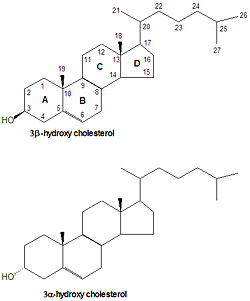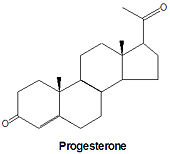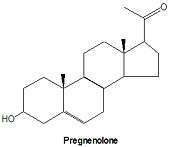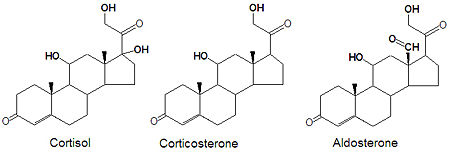Steroid
Steroids, or steroid hormones are powerful hormones with drastic effects, both good and bad, when artificially introduced into living systems. Athletes have often taken anobolic steroids to improve muscle growth and athletic performance. Glucocorticoids play a role in inflamation, and estrogens have been linked to cancer. Testosterone and estrogen influence sexual traits (maleness/femaleness). All steroid hormones are naturally synthesized from cholesterol. The five major classes of steroids are: progestagens, glucocorticoids, mineralcorticoids, androgens and estrogens. The steroid hormones activate gene expression by binding to enhancer proteins, called steroid receptors.
cholesterol (C27)
Cholesterol is the precursor from which all steroid hormones are synthesized. Because of this, all steroid numbering and nomenclature follow that of cholesterol. Some cholesterol derivatives have a proton added to the C-5 carbon. If the H-5 proton is alpha-oriented (points down) then rings A and B are fused in a trans conformation, but in the beta orientation, the rings are fused in a cis conformation. All steroids with an H5 are in the 5 orientation, while bile salts derived from cholesterol have the 5 orientation.
pregnenolone and progestagens
All steroid hormones have 21 or fewer carbons, although their precursor cholesterol has 27 carbon atoms. pregnenolone is the first steroid derived from cholesterol. It is synthesized through an intermediate, 20,22-dihydroxy-cholesterol, which is subsequently oxidized at C-20 to form a ketone with cleavage of carbons 22-27.
Progesterone, a progestagen which prepares the lining of the uterus for implantation of an ovum, is biosynthesized from prognenolone by oxidation of the 3-hydroxy group into a 3-keto group and by the isomerization of the 5 double bond into a 4 double bond. This hormone is also essential to maintain pregnancy. Progresterone is the precursor chemical in the biosynthesis of corticoids and androgens.
glucocorticoids and mineralcorticoids
Glucocordicoids and mineralocrticoids (or mineralcorticoids) are naturally synthesized by the oxidation of progesterone. Cortisol is produced when progesterone is hydroxylated at three positions, C-11, C-17 and C21. The oxidation of the C-17 carbon must occur before the hydroxylation at C-21 to synthesize cortisol, otherwise corticosterone is formed. Aldosterone, the major mineralcorticoid, is synthesized from corticosterone by oxidation of the C-18 methyl group to form an aldehyde.






